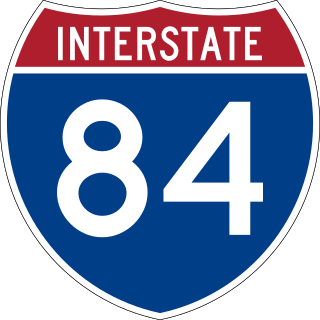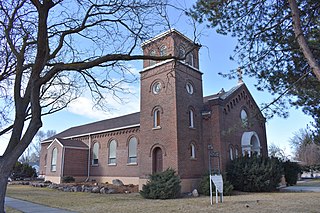
The Idaho Black History Museum is a museum of African American history and culture located at 508 Julia Davis Drive in Boise, Idaho, in the United States. It is the oldest African American museum in the Pacific Northwest.

The Idaho Black History Museum is a museum of African American history and culture located at 508 Julia Davis Drive in Boise, Idaho, in the United States. It is the oldest African American museum in the Pacific Northwest.
St. Paul Baptist Church was constructed in 1921. The original location was at the corner of Warm Springs and Broadway Avenues. [1] The congregation, founded in 1909 by Rev. William Riley Hardy, [2] worshipped in homes and rented structures [3] until the permanent church building was finished. [1] Small, wood-frame chapel was included on the National Register of Historic Places in 1982. [4] It was the first African American church in Idaho, [1] and for almost all its history was the largest Black congregation in Idaho. [3]
Having outgrown the building, the congregation resolved in 1994 to sell it to the city for use as a Black history museum. [5] The congregation worshipped in the structure until 1995. [1]
Preserving St. Paul Baptist Church was a major goal of Mary Hardy Buckner, a long-time member of the congregation. She encouraged her daughter, Cherie Buckner-Webb, to find a way to avoid its demolition. [1] Buckner-Webb established a foundation in 1996 to take ownership of the church building, but this required moving it from the land on which it sat. The group raised $120,000 to move the structure and establish a museum in it once it reached its new location. [6] The city of Boise agreed to allow the building to be moved to a spot on the outskirts of Julia Davis Park. [7] The building was relocated in 1998. [4] Local artist Cherie Lindley conserved the building's original eight stained glass windows prior to the museum's opening. [8]
The museum dates its founding to 1995, [7] making it the oldest African American history museum in the Pacific Northwest, [4] but did not open its doors until 1999. [4]
The Idaho Black History Museum focuses on African Americans in Idaho from the early 1800s to the present. The museum's permanent display, "The Invisible Idahoan: 200 Years of Blacks in Idaho", was created with the assistance of Dr. Mamie Oliver, the first African American professor at Boise State University. [4] Other exhibits contain artifacts and displays on Aurelius Buckner, the first Black athlete at Boise State University; Dorothy Buckner, African American activist who succeeded in pushing the Idaho legislation to adopt a civil rights bill in 1961; Cherie Buckner-Webb, the first Black legislator in the state of Idaho, and the history of the Ku Klux Klan's attempts to intimidate African Americans in the state. [9] The museum's collection also included a sizeable number of works of African American art. The museum's programming includes films, lectures, films, performances, and workshops. [4]
The museum's currect executive director is Phillip Thompson, Mary Hardy Buckner's great-grandson. [1] The museum suffered a significant financial crisis in 2007 that required it to lay off staff and reduce its hours [4] In 2016, the museum was vandalized when someone wrote a racial slur in the snow on the roof of the museum's storage facility. [10]

Boise is the capital and most populous city in the U.S. state of Idaho and is the county seat of Ada County. As of the 2020 census, there were 235,684 people residing in the city. On the Boise River in southwestern Idaho, it is 41 miles (66 km) east of the Oregon border and 110 miles (177 km) north of the Nevada border. The downtown area's elevation is 2,704 feet (824 m) above sea level.
The Idaho Statesman is the daily newspaper of Boise, Idaho, in the western United States. It is owned by The McClatchy Company.

The Diocese of Boise is a Latin Church ecclesiastical territory, or diocese, of the Catholic Church in Idaho in the United States.

First African Baptist Church, located in Savannah, Georgia, claims to be derived from the first black Baptist congregation in North America. While it was not officially organized until 1788, it grew from members who founded a congregation in 1773. Its claim of "first" is contested by the Silver Bluff Baptist Church, Aiken County, South Carolina (1773), and the First Baptist Church of Petersburg, Virginia, whose congregation officially organized in 1774.

Interstate 84 (I-84) in the U.S. state of Idaho is a major Interstate Highway that traverses the state from the Oregon state line in the northwest to Utah state line in the southeast. It primarily follows the Snake River across a plain that includes the cities of Boise, Mountain Home, and Twin Falls. The highway is one of the busiest in Idaho and is designated as the Vietnam Veterans Memorial Highway.

Julia Davis Park is a municipal park in the western United States, located in the downtown region of Boise, Idaho. Created in 1907 with a land donation from Thomas Jefferson Davis, it is the first park in the "String of Pearls", a series of parks along the Boise River operated by the city's Parks and Recreation Department.

The Church of Jesus Christ of Latter-day Saints in Idaho refers to the Church of Jesus Christ of Latter-day Saints and its members in Idaho. Rexburg, Idaho is home to Brigham Young University–Idaho. Idaho has the third most church members of any U.S. state, and the second-highest percentage of members. The LDS Church is the largest denomination in Idaho, with the largest presence in Eastern Idaho.

Cathedral of the Rockies, also known as the Cathedral of the Rockies First United Methodist Church, is a United Methodist church located in the historic North End district of Boise, Idaho, United States. The church is the largest United Methodist Church in Boise, Idaho, the largest in the Oregon-Idaho Conference of the United Methodist denomination, and was the first Methodist church in Boise, founded in 1872.
Cherie Buckner-Webb is a Democratic politician from Boise, Idaho. In 2010 Buckner-Webb was elected to a single term in the Idaho House of Representatives representing the north Boise-based District 19. In 2012 Buckner-Webb won the district's Idaho Senate seat, succeeding the retiring Nicole LeFavour. She is Idaho's first elected African-American state legislator, and its first African-American woman legislator.
The St. Paul Missionary Baptist Church in Boise, Idaho is a historic Baptist church founded in 1909, and its building at 124 Broadway Avenue which was built in 1921. The building was added to the National Register of Historic Places in 1982.

The National Weather Service Boise, Idaho is a weather forecast office responsible for weather forecasts, warnings and local statements as well as aviation weather forecasts and fire weather forecasts for 3 counties in Southeast Oregon and 14 counties in Southwest and South central Idaho. The U.S. Weather Bureau established an office in the Sonna Building on December 1, 1898. Since then, the U.S Weather Bureau office, now known as the National Weather Service forecast office gained forecast responsibility of Southern Idaho on June 22, 1970 which was expanded to the entire state of Idaho in 1973. After modernization in 1993, the forecast responsibility was changed to Southeast Oregon and Southwest Idaho. The current office in Boise maintains a WSR-88D (NEXRAD) radar system, 8 Automated airport weather station (ASOS) systems and Advanced Weather Interactive Processing System (AWIPS) that greatly improve forecasting in the region. Continuous weather observations have been maintained for the city of Boise since February 1, 1864 about 5 months after the U.S. Army established Fort Boise. The post surgeon for the U.S. Army took observations until July 1, 1877 when the U.S. Signal Service, established an office downtown. The Signal Office was discontinued on July 1, 1890.

The Anne Frank Human Rights Memorial is a .81 acres (0.33 ha) cenotaph complex and educational park in Boise, Idaho near the Boise Public Library and the Greenbelt, the centerpiece of which is a statue of Anne Frank; it is jointly maintained by the Wassmuth Center for Human Rights and the Boise Department of Parks and Recreation, and is the only human rights memorial in the U.S. Designed by Idaho Falls architect Kurt Karst, a sapling of the Anne Frank Tree and quotations from some sixty notables and unknowns are prominent installations. It also features one of the few installations where the full text of the Universal Declaration of Human Rights is on permanent public display. The park has been recognized and accepted by the International Coalition of Sites of Conscience. It was thoroughly renovated in September 2018, with an outdoor classroom and a new sculpture, "The Spiral of Injustice."

The Idaho Building in Boise, Idaho, is a 6-story, Second Renaissance Revival commercial structure designed by Chicago architect, Henry John Schlacks. Constructed for Boise City real estate developer Walter E. Pierce in 1910–11, the building represented local aspirations that Boise City would become another Chicago. The facade features brick pilasters above a ground floor stone base, separated by seven bays with large plate glass windows in each bay. Terracotta separates the floors, with ornamentation at the sixth floor below a denticulated cornice of galvanized iron.

The Hoff Building is an historic building in the western United States, located in Boise, Idaho. Designed by Boise architects Tourtellotte & Hummel, it was constructed 94 years ago in 1930 in the style of Art Deco. Known as Hotel Boise until 1976, the building is a contributing resource in the Boise Capitol Area District, listed on the National Register of Historic Places since May 12, 1976.

Bishop Daniel S. Tuttle House is a nonresidential building adjacent to St. Michael's Episcopal Cathedral in Boise, Idaho. The building was designed by local architects Wayland & Fennell and constructed in 1907 under the direction of Bishop Funsten of the Episcopal Diocese of Idaho, and the building commemorates the work of Daniel S. Tuttle, first bishop of Idaho.

St. Mary's Catholic Church is a red brick, Italianate Romanesque Revival building designed by Tourtellotte and Hummel and constructed by H.J. McNeel in 1925 in Caldwell, Idaho. The church features an 80-ft tower, and the building was added to the National Register of Historic Places in 1982.

The Cyrus Jacobs House, also known as the Cyrus Jacobs-Uberuaga House and the Basque Museum and Cultural Center, in Boise, Idaho, is a 1+1⁄2-story brick house constructed by Charles May in 1864. The house was added to the National Register of Historic Places in 1972.